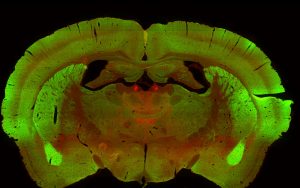Functional dynamics of opioid receptors
Dominique MASSOTTE

Presentation
The opioid system is involved in a wide range of physiological outcomes. It modulates pain perception, affective behaviour and reward to natural stimuli such as food. It is involved in attention, learning and memory processes, controls autonomic functions and affects locomotor activity. It also plays a key role in the response of the organism to stress. In addition, this neuromodulatory system is the molecular target of opiates that have been used for centuries for their potent analgesic properties. However, tolerance develops during chronic opiate administration which represents a major limitation to their therapeutic use. Moreover, opiates possess euphoric properties promoting their abuse and/or misuse thereby leading to drug addiction.
 Our projects address the dynamics of opioid receptors in terms of neuroanatomical distribution, signalling and trafficking in their native environment both in physiological and pathological conditions. We aim at identifying molecular mechanisms by which these receptors modulate the activity of neurons and neural networks and, adapt to chronic opiates. An important axis focuses on the specific molecular and cellular mechanisms of heteromers resulting from the association of two different opioid receptors, mainly mu and delta, or involving an opioid receptor and a non-opioid one. Our goal is to determine the impact of such heteromers on the cellular physiology and behavioral responses and to evaluate their potential as novel therapeutic targets. We explore strategies targeting opioid heteromers in the context of chronic pain for which current opiate-based therapies remain poorly efficient and, which therefore represents a crucial unmet socioeconomical challenge. We also examine their therapeutic potential in the context of addictive behaviors towards opiate drugs and palatable food, a gateway to obesity that represents another major health issue. To these aims, we combine ex vivo and in vivo molecular, cellular and pharmacological approaches with behavioural tests and genetically modified mice.
Our projects address the dynamics of opioid receptors in terms of neuroanatomical distribution, signalling and trafficking in their native environment both in physiological and pathological conditions. We aim at identifying molecular mechanisms by which these receptors modulate the activity of neurons and neural networks and, adapt to chronic opiates. An important axis focuses on the specific molecular and cellular mechanisms of heteromers resulting from the association of two different opioid receptors, mainly mu and delta, or involving an opioid receptor and a non-opioid one. Our goal is to determine the impact of such heteromers on the cellular physiology and behavioral responses and to evaluate their potential as novel therapeutic targets. We explore strategies targeting opioid heteromers in the context of chronic pain for which current opiate-based therapies remain poorly efficient and, which therefore represents a crucial unmet socioeconomical challenge. We also examine their therapeutic potential in the context of addictive behaviors towards opiate drugs and palatable food, a gateway to obesity that represents another major health issue. To these aims, we combine ex vivo and in vivo molecular, cellular and pharmacological approaches with behavioural tests and genetically modified mice.
- Katia Befort (LNCA, Strasbourg, France)
- Christiane Faeste (Veterinary Institute, Oslo, Norway)
- Sandra Lecat (ESBS, Illkirch-Graffenstaden)
- Susruta Majumdar (University School of Medicine, St Louis, Missouri, USA)
- Florence Noble (University Paris Descartes, Paris, France)
- Martine Schmitt (Faculty of Pharmacy, University of Strasbourg, Illkirch Graffenstaden)
- Stefan Schultz (University of Jena, Germany)
- Mariana Spetea (University Innsbruck, Austria)












